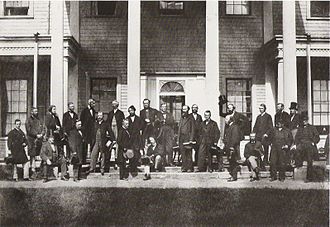Canadian Confederation







Canadian Confederation
Canadian Confederation was the process by which the British colonies of Canada, New Brunswick, and Nova Scotia were united into one Dominion of Canada on July 1, 1867. This event marked the beginning of a new nation, with its own federal government and constitution, while still remaining part of the British Empire.
Background[edit]
The idea of uniting the British North American colonies had been discussed for many years. Factors such as economic challenges, defense concerns, and political deadlock in the Province of Canada (which was divided into Canada West and Canada East) contributed to the push for Confederation. The Charlottetown Conference in 1864 was a pivotal meeting where representatives from the colonies discussed the possibility of a union.
Key Conferences[edit]
Several key conferences were held to negotiate the terms of Confederation:
- Charlottetown Conference (1864) - Initially intended to discuss a maritime union, it became the first meeting to discuss a larger union of all British North American colonies.
- Quebec Conference (1864) - Delegates from the Province of Canada, New Brunswick, Nova Scotia, and Prince Edward Island met to draft the Quebec Resolutions, which outlined the framework for Confederation.
- London Conference (1866) - The final conference where the British North America Act (now the Constitution Act, 1867) was drafted and agreed upon.
British North America Act[edit]
The British North America Act, 1867 was the legislation passed by the Parliament of the United Kingdom that created the Dominion of Canada. It established the federal structure, dividing powers between the federal government and the provinces. The Act served as Canada's constitution until it was patriated in 1982, becoming the Constitution Act, 1982.
Initial Provinces[edit]
The original provinces that joined Confederation in 1867 were:
- Ontario (formerly Canada West)
- Quebec (formerly Canada East)
- New Brunswick
- Nova Scotia
Expansion of Canada[edit]
After 1867, other provinces and territories joined Canada:
- Manitoba (1870)
- British Columbia (1871)
- Prince Edward Island (1873)
- Alberta and Saskatchewan (1905)
- Newfoundland and Labrador (1949)
Significance[edit]
Canadian Confederation was a significant milestone in the country's history, laying the foundation for its political and legal systems. It allowed for greater economic cooperation and defense coordination among the provinces and established a framework for future expansion and development.
Related Pages[edit]
- History of Canada
- Province of Canada
- Charlottetown Conference
- Quebec Conference
- London Conference
- British North America Act, 1867
- Constitution Act, 1982
- List of Canadian provinces and territories by date of entry
Categories[edit]
This article is a Canadian history stub. You can help WikiMD by expanding it!
Ad. Transform your life with W8MD's Budget GLP-1 injections from $75


W8MD offers a medical weight loss program to lose weight in Philadelphia. Our physician-supervised medical weight loss provides:
- Weight loss injections in NYC (generic and brand names):
- Zepbound / Mounjaro, Wegovy / Ozempic, Saxenda
- Most insurances accepted or discounted self-pay rates. We will obtain insurance prior authorizations if needed.
- Generic GLP1 weight loss injections from $75 for the starting dose.
- Also offer prescription weight loss medications including Phentermine, Qsymia, Diethylpropion, Contrave etc.
NYC weight loss doctor appointmentsNYC weight loss doctor appointments
Start your NYC weight loss journey today at our NYC medical weight loss and Philadelphia medical weight loss clinics.
- Call 718-946-5500 to lose weight in NYC or for medical weight loss in Philadelphia 215-676-2334.
- Tags:NYC medical weight loss, Philadelphia lose weight Zepbound NYC, Budget GLP1 weight loss injections, Wegovy Philadelphia, Wegovy NYC, Philadelphia medical weight loss, Brookly weight loss and Wegovy NYC
|
WikiMD's Wellness Encyclopedia |
| Let Food Be Thy Medicine Medicine Thy Food - Hippocrates |
Medical Disclaimer: WikiMD is not a substitute for professional medical advice. The information on WikiMD is provided as an information resource only, may be incorrect, outdated or misleading, and is not to be used or relied on for any diagnostic or treatment purposes. Please consult your health care provider before making any healthcare decisions or for guidance about a specific medical condition. WikiMD expressly disclaims responsibility, and shall have no liability, for any damages, loss, injury, or liability whatsoever suffered as a result of your reliance on the information contained in this site. By visiting this site you agree to the foregoing terms and conditions, which may from time to time be changed or supplemented by WikiMD. If you do not agree to the foregoing terms and conditions, you should not enter or use this site. See full disclaimer.
Credits:Most images are courtesy of Wikimedia commons, and templates, categories Wikipedia, licensed under CC BY SA or similar.
Translate this page: - East Asian
中文,
日本,
한국어,
South Asian
हिन्दी,
தமிழ்,
తెలుగు,
Urdu,
ಕನ್ನಡ,
Southeast Asian
Indonesian,
Vietnamese,
Thai,
မြန်မာဘာသာ,
বাংলা
European
español,
Deutsch,
français,
Greek,
português do Brasil,
polski,
română,
русский,
Nederlands,
norsk,
svenska,
suomi,
Italian
Middle Eastern & African
عربى,
Turkish,
Persian,
Hebrew,
Afrikaans,
isiZulu,
Kiswahili,
Other
Bulgarian,
Hungarian,
Czech,
Swedish,
മലയാളം,
मराठी,
ਪੰਜਾਬੀ,
ગુજરાતી,
Portuguese,
Ukrainian